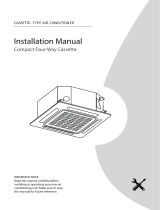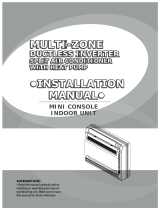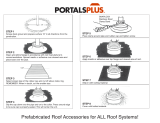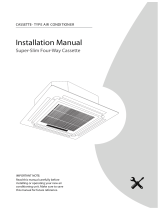
Page 17
Outdoor Unit
Installation
Outdoor Unit Installation
Outdoor Unit Installation Instructions
Step 1: Select installation location.
The outdoor unit should be installed in the
location that meets the following requirements:
Place the outdoor unit as close to the indoor
unit as possible.
Ensure that there is enough room for
installation and maintenance.
The air inlet and outlet must not be
obstructed or exposed to strong wind.
Ensure the location of the unit will not be
subject to snowdrifts, accumulation of
leaves or other seasonal debris. If possible,
provide an awning for the unit. Ensure the
awning does not obstruct airflow.
The installation area must be dry and well
ventilated.
There must be enough room to install the
connecting pipes and cables and to access
them for maintenance.
The area must be free of combustible gases
and chemicals.
The pipe length between the outdoor and
indoor unit may not exceed the maximum
allowable pipe length.
If possible, DO NOT install the unit where it
is exposed to direct sunlight.
If possible, make sure the unit is located far
away from your neighbors’ property so that
the noise from the unit will not disturb them.
If the location is exposed to strong winds (for
example: near a seaside), the unit must be
placed against the wall to shelter it from the
wind. If necessary, use an awning. (See Fig.
5.1 & 5.2)
Install the indoor and outdoor units, cables
and wires at least 1 meter from televisions or
radios to prevent static or image distortion.
Depending on the radio waves, a 1 meter
distance may not be enough to eliminate all
interference.
Strong wind
Strong wind
Fig. 5.1
Fig. 5.2
5
√
√
√
√
√
√
√
√
√
√
√
√
√
√
√
√
√
NOTE:
All the pictures in this manual are for explanation
purpose only. They may be slightly dierent from
the air conditioner you purchased(depend on
model).The actual shape shall prevail.
The support is at and horizontal and can stand
the weight of the outdoor unit. And will no
additional noise or vibration.
It is easy to install the connecting pipes or
cables.
Determine the air outlet direction where the
discharged air is not blocked.
If necessary, install a blind that does not
interfere with the air ow.
During the heating mode, the water drained o
the outdoor unit ,The condensate should be well
drained away by the drain hole to an
appropriate place, so as not to interfere other
people.
The minimum distance between the outdoor
unit and obstacles described in the installation
chart does not mean that the same is applicable
to the situation of an airtight room.

























